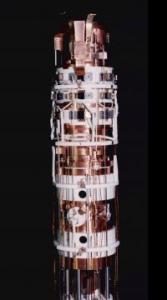Sep 6 2010
The physicists of the National Institute of Standards and Technology (NIST) have exploited miniature ion crystals for measuring forces in the yoctonewton range. The yoctonewton (mass equivalent to that of a copper atom and a septillionth of a newton unit) measurement of the minute forces is employed in nanoscale science, basic theories of physics and force microscopy.
 NIST Force Sensor
NIST Force Sensor
The ultra-miniature forces are measured normally utilizing a small oscillator which operates mechanically. Nature Nanotechnology explains about a novel sensor developed by NIST, which is made out of a plane crystal with approximately 60 beryllium ions captured in a vacuum cavity using electromagnetic fields and chilled to a degree in the range of 500 millions greater than the absolute zero level employing an ultraviolet laser. The device was advanced over the preceding 15 years exploiting quantum computing and ion plasmas. The yoctonewton measurements emerging from an applied electric field was utilized in this aspect. The experiment suggested that nearly 390 yoctonewtons could be measured rapidly within one second with great flexibility that signifies the high sensitivity of the technique and sensitivity is of great advantage for various practical applications.
Previously, another physicist from NIST measured the minute forces which were 1,000 fold greater in range or 500 zeptonewtons within one second, utilizing an oscillator that functions mechanically but it could only sense the forces which falls in the yoctonewton scale and also failed to provide any accurate measurements.
The unique ion sensor specified in Nature Nanotechnology operates by monitoring the action of the applied force on the motion of ions, based on fluctuations in the laser light reflected from the ions. The tiny fluctuating electric field on the crystal forces the ions to oscillate and as a result, the force of the reflected laser light vibrates in synchronization with the motion of the ion. The alteration of the reflected laser with respect to the force can be detected employing a measure induced movement of the ion. The methodology is flexible due to great response of the excited particles to the peripheral electric fields, the less weight of the ions and the capacity to measure nanometer range deviations in the motion of ions.
The Defense Advanced Research Projects Agency partially funded the research and M.J. Biercuk and H. Uys carried out the research work.